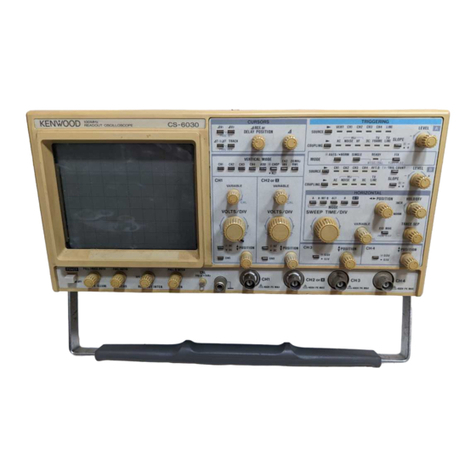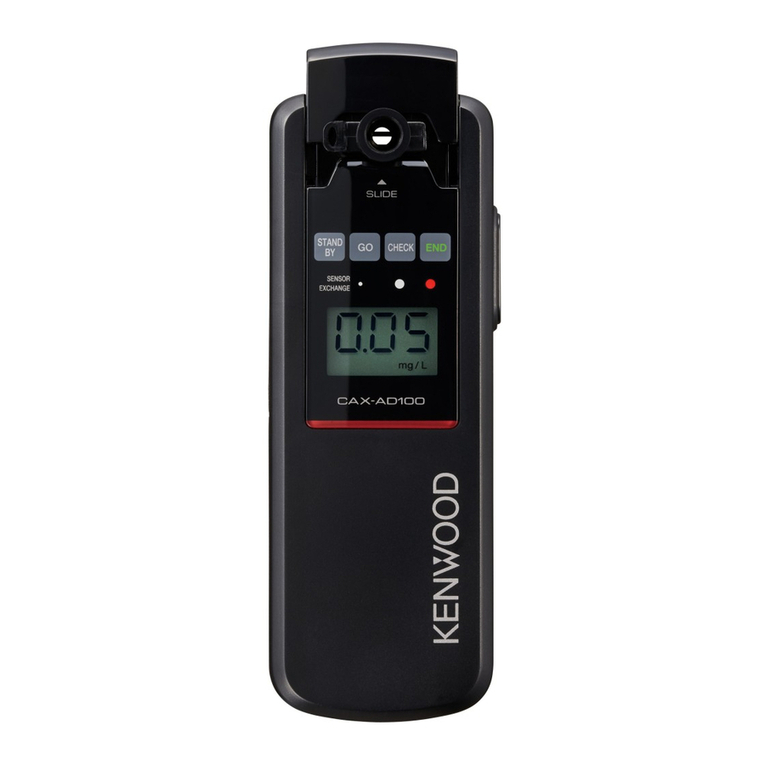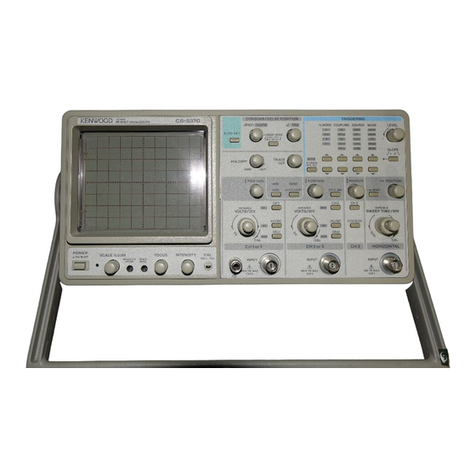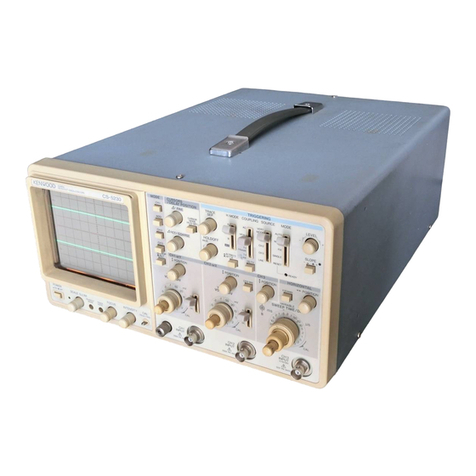
differencebetweenCH1andCH2isdisplayed
(CH1
- CH2).
5.
Whenthesignalvoltageismorethan2mVand
waveformfailstoappearonthe
screen,
theos-
cilloscope
maybecheckedbyfeedinginput
fromCAL1 Vp-p(23).
Since
calibration
voltageis1 Vp-p,thewaveformbecomes5 div
highatthe0.2/divposition.
6.
Bypushing
TRIG
LEVEL
(19).thefree-running
autofunctionis
released.
Thewaveformdis-
appears
whentheknobisturnedclockwise,
and
appearsagainwhenitisreturnedtoitsap-
proximatemiddlepositionofit.
Sync
phaseis
also
adjustableinthis
case.
Thewaveformwill
again
disappearwhentheknobisturned
counterclockwise
fromthemidposition.
7.
WhenDCcomponentismeasured,set
AC-GND-DC
(3)or(9)toDCposition.If,in
this
case,
theDCcomponentcontainsplus
"+ " potential,thewaveformmovesupward
and
ifitcontainsminus" —"potential,the
waveformmovesdownward.
The
reference
point
of"0"potentialcanbe
checked
atGNDposition.
POWER
SUPPLY
The
oscilloscopeisdesignedtooperateonAC,in-
ternalbatteryorexternalDC.
AC
operation
For
ACoperation,firstsetthepowervoltage
selec-
torswitchtothevoltageofyourlocalACcurrent.
Then,
connecttheACcord.Theconnectionofthe
AC
cordautomaticallydisconnectstheinternal
battery.
Operationoninternalbattery(option)
Install
thebatterypackintheoscilloscopeaccoring
tothefollowingsequence(refertothediagramon
therearofthe
case):
*OpenthepackageofthebatterypackBP-7(op-
tion)andchecktomakesurethatitcontainstwo
6V
leadbatteriesandconnecting
leads.
*
Place
theoscilloscopewiththeupsidedown,
removethe4
screws
on
both
sides
usinga
screwdriver.
Holdthecordreelandpullitout.
The
battery
case
coverwillberemoved.
*
Release
theleadfromthecordclamperandthen
removethescrew(4x 40mm)asshowninthe
diagram.
*Connectthe2 batteriesin
series
usingthecon-
necting
leads,
thenconnecttheleads(redand
black)
oftheoscilloscopetothebatteries.Make
sure
thattheredleadisconnectedto"+"and
theblackleadto" —"side.
*Afterthebatterieshavebeenconnected,insert
thebattery
case
fromtherearandreplacethe
battery
case
cover.Thebatteryleadsshouldbe
arranged
ontopofthebatteriessothattheyare
notcaughtbetweenthebatteriesandthebattery
case.
*Tightenthe4
screws
fromeachsideofthe
case
and
thescrew(4x 40mm)fromtherearofthe
case.
Now,theoscilloscopeisreadyforoperation.
Refer
totheinstructionsinthepreviousparagraph
"Con-
trolson
Panels".
Withtheinternalbattery,theos-
cilloscope
canbeoperatedformorethan2 hours,
althoughthisdependsontheconditionofthe
battery.
When
thebatteryvoltagefallsdownto10Vduring
operation,theprotectioncircuitisactivatedtoshut
offthebatterycircuit.Inthis
case,
thepowerlamp
goes
offindicatingthatthebatteryisprotected
against
over-discharge.Whenthishappens,the
batteryshouldberechargedfullyandimmediately,
(refer
toitem"BatteryCharging")
The
powerlampwillstartblinkingtoindicate
batteryvoltagedrop10minutesbeforetheprotec-
tion
circuitoperates.
OperationonexternalDC(11~
15.5V)
Connect
a DCpowercordfromDC12Vreceptacle
(31)
toa nominal12voltDCpowersource(11to
15.5
VDC),suchasa vehiclecigarettelighter.
Observe
properpolarity;theoscilloscopeis
protectedagainstreversepolaritydamage,butwill
notoperateifpolarityis
reversed.
Turn
on
POWER/INTEN
control(14).
POWER
indicator(12)shouldglow,andthescope
is
readyforuse.
If
CHARGE
indicator(13)glows,thebatteriesare
chargingtheindicatorgoesoffwhenthebatteries
are
fullycharged.
BATTERY
CHARGING
To
chargetheinternalbattery,connecttheACline
cordtoACoutlet.Thebatteryischarged
regardless
ofthepositionofthepowerswitch.
When
batterychargeisstarted,the
CHARGE
lamp
will
light.
Withthepowerswitchsetto
OFF,
the
batteryisfullychargedinabout16hours.Withthe
switch
settoON,thebatteryischargedinabout
28
hours;theoscilloscopecanbeusedwhilethe
batteryisbeingcharged.Theexternalpowercon-
8



















































